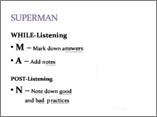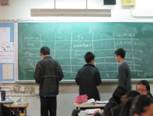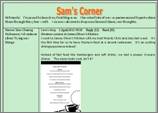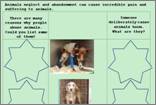After analysing students’ needs, the teachers tried to translate the possible solutions into concrete actions.
| I. |
Formal curriculum planning: designing task-based units of work at the pre-, while-, and post-listening stages |
| |
- |
The following is a simplified action plan: |
|
Level/ unit |
Purpose |
L/T task |
|
| S1/Camping |
| - |
To increase students’ awareness of what they can do at the pre-, while-, and post-listening stages |
| - |
To develop listening sub-skills (core)*: improving skills in extracting specific information by identifying key words |
| - |
To provide language/ vocabulary input |
|
| Context and task setting |
| - |
Students will visit a cooking school soon. Before the visit, they will learn more about Western style food, cooking methods, and table manners. One of the listening tasks is to listen to a chef talking about his work and fill in a flow chart. |
Pre-teaching of skills |
| - |
SUPERMAN: Students learn the strategy. At the pre-listening stage, they study instructions, underline key words, and make predictions. They also stay relaxed and focused. When they listen, they mark down what a speaker has said in note-form and use short forms/ symbols as far as possible. After listening, students reflect on their performance and make plans for improvement.
Students are reminded to use this strategy when they do listening tasks in future
|
| - |
Note-taking skills: Students improve the recording of information as they listen by learning more about note-taking skills. They learn about what content words are, and learn to use short forms and create their own symbols. |
Pre-listening task |
| - |
Activating prior knowledge: students think of three things to bring for the camping activity. The class discusses what to bring, why and why not, and come up with a list of things to bring.
|
| - |
Language/ vocabulary input: Expand students’ vocabulary on things to bring for camping and revisit modal verbs.
|
| - |
Making predictions: Before listening to speakers talking about what they need to bring for camping, students study the instructions and questions. With teacher guidance, they predict the key words (modals) which may give them ideas what the speakers must bring, may bring and should not bring. |
While-listening |
| - |
Listening for specific information: Students listen for key words – modals – in order to decide on the things to bring. They also apply the note-taking skills they have learnt to mark down useful information. |
Post-listening |
| - |
Debriefing: After checking answers, students justify their answers by quoting the modal verbs used in the audio clip.
|
| - |
Listening diaries: Students complete a listening diary. They reflect on the strategies used, what they have done well and what they should improve. |
|
| |

|

|
Learning to be a listening ‘SUPERMAN’ |

 |
Learning commonly used symbols and creating own symbols for note-taking |

|
Keeping a listening diary for self-reflections and making plans for improvement |
|
| S1/ Food |
| - |
To sustain students’ habit of using pre-, while-, and post-listening strategies |
| - |
To develop listening sub-skills (core)*: identifying a sequence of events and understanding the connections between ideas by identifying a range of cohesive devices |
| - |
To provide language/ vocabulary/ reading input |
|
| Context and task setting |
| - |
Students will visit a cooking school soon. Before the visit, they will learn more about Western style food, cooking methods, and table manners. One of the listening tasks is to listen to a chef talking about his work and fill in a flow chart. |
Consolidation of skills |
| - |
Students recap the strategy SUPERMAN and note-taking skills and keep up a habit of using the strategies. |
Pre-listening |
| - |
Language/ vocabulary input: Students learn vocabulary about cooking methods, adjectives to describe food, synonyms, and sequential words.
|
| - |
Reading input: Students are exposed to a range of text types – blogs, articles, web pages, charts and notices – to learn more about the topic and text features.
|
| - |
Making predictions: Students study a flow chart to make predictions. They pay attention to the features of the flow chart and anticipate that each line begins with a bare infinitive. They also predict that sequential words may appear as there are arrows pointing down. |
While-listening |
| - |
Listening for specific information: Students listen for key words – bare infinitives and sequential words – in order to identify a sequence of actions and understand the connections between ideas. This can help them complete the flow chart. They also apply the note-taking skills they have learnt to jot down key information. |
Post-listening |
| - |
Debriefing: Students discuss if they have put down a bare infinitive for the first word of each line and check if the actions are in the correct position with reference to the sequential words used.
|
| - |
Listening diaries: Students complete a listening diary. They reflect on the strategies they have used, what they have done well and what they should improve. |
|
| |

Expanding vocabulary bank to prepare for the listening task |

Reading a blog about Western food and table manners for more input
|

Studying the text features of a flow chart |
|
| S2/ Animals |
| - |
To sustain students’ habit of using pre-, while-, and post-listening strategies |
| - |
To develop listening sub-skills (core)*: identifying attitudes and feelings of speakers based on intonation |
| - |
To provide language/ vocabulary/ reading/ listening skills input |
|
| Context and task setting |
| - |
Recently, some animal abuse cases have been reported. Students will learn more about the topic and voice their opinions about the issue. One of the listening tasks is to listen to different people talking about their views. |
Consolidation of skills |
| - |
Students recap the strategy SUPERMAN and note-taking skills and keep up a habit of using the strategies. |
Pre-listening |
| - |
Language/ vocabulary input: Students learn vocabulary about feelings and attitudes in the context of animal abuse.
|
| - |
Reading input: Students are exposed to a range of text types such as newspaper articles, discursive essays, argumentative essays, and letters to the editor, to learn more about the topic
. |
| - |
Listening skills input: Students listen to speakers speaking with rising and falling tones and learn about their feelings and attitudes.
|
| - |
Making predictions: Before listening to speakers talking about animals, students brainstorm adjectives for describing the speakers’ feelings and emotions. |
While-listening |
| - |
Listening for attitudes and feelings: Students pay attention to the intonation of the speakers to identify their attitudes and feelings. |
Post-listening |
| - |
Debriefing: Students check the answers. Teachers invite some students to read aloud the sentences with appropriate intonation.
|
| - |
Listening diaries: Students complete a listening diary. They reflect on the strategies they have used, what they have done well and what they should improve. |
|
| |

Learning adjectives for describing feelings and attitudes |
|

Understanding the causes of animal abuse |
| |
|
| S2/ Musical plays |
| - |
To sustain students’ habit of using pre-, while-, and post-listening strategies |
| - |
To develop listening sub-skills (core)*: identifying attitudes and feelings of speakers based on stress and intonation and choice of words |
|
| Context and task setting |
| - |
Students will learn to review a play/ film in preparation for SBA. One of the listening tasks is to watch a number of school musical play extracts and identify the actors’ attitudes and feelings. |
Consolidation of skills |
| - |
Students recap the strategy SUPERMAN and note-taking skills and keep up a habit of using the strategies. |
Pre-listening |
| - |
Reading input: Students read articles about Ancient Egypt to understand the historical background of the musical play ‘A Vision in a Dream’. |
| - |
Language/ vocabulary input: Students learn vocabulary about the play. They also learn more words to describe feelings and attitudes. In pairs, a student picks an adjective and reads aloud a monologue to his partner. The partner then guesses the emotions/ attitudes demonstrated.
. |
| - |
Listening skills input: Apart from paying attention to intonation, students learn to tell a speaker’s attitudes and feelings through the words used.
|
| - |
Making predictions: Before students listen to Joseph, the main character of the musical play, they predict his intonation and the words he used. |
While-listening |
| - |
Listening for attitudes and feelings: Students pay attention to the intonation and choice of words of Joseph to identify his attitudes and feelings. |
Post-listening |
| - |
Debriefing: Students check the answers. Students justify their answers by describing Joseph’s intonation and identifying key words to show his feelings and attitudes.
|
| - |
Listening diaries: Students complete a listening diary. They reflect on the strategies they have used, what they have done well and what they should improve.
|
| - |
Extended listening task: Students watch an extract of other plays and identify the speakers’ feelings and attitudes based on the choice of words and intonation. |
|
| |

Teachers discussing how to help students identify speakers’ emotions and attitudes |
| |

|
Explaining the background of Ancient Egypt |

Consolidating listening skills with a tailormade play. |
|
*Only the core listening sub-skills covered in the unit are reported. Other listening skills covered in the unit are not recorded in this article.
| II. |
Formal curriculum planning: designing and using an IPA booklet |
As many students fail to record information while listening, an IPA booklet was designed for S1 – S3. Students learned more about letter-sound relationship to improve their spelling. This would be beneficial to students when they attempt open-cloze questions in the listening assessment of TSA and HKDSE.
With the booklet, students not only learnt letter sounds, but also intonation and stress. Such knowledge would help them recognise emotions and identify attitudes of speakers. |

|
| III. |
Increasing exposure through informal curriculum planning |
| Listening to English inside the English classroom alone is not enough to improve students’ listening skills. To increase their exposure, the teachers introduced a range of English activities as part of the informal curriculum, such as musical play appreciation, theme-based presentations, and seminars/ coffee talks with outside partners such as the US Consulate General. They also linked the formal and informal curricula as much as possible. For example, after watching the musical play, the S2 students completed the unit on musical plays in the English classroom. The teachers also improved the English-rich environment by inviting students to make announcements in English during the English Week. |
| IV. |
Use of resources |
| The teachers made use of a range of resources to facilitate student learning. |
Resource type |
Purpose |
| • |
Human resources |
| |
| - |
Seek help from the NET and student helpers to record audio/ video clips for learning/ teaching purposes |
| - |
Invite outside partners who are native speakers to conduct seminars and coffee talks |
|
|
| • |
To improve students’ exposure to a wide range of accents and maximise their listening opportunities in both the formal and informal curricula |
|
| • |
Listening resources |
| |
| - |
Adapt ready-made listening resources from textbooks and listening skills books |
| - |
Adapt audio/ video clips collected from school-based English activities such as musical plays |
|
|
| • |
To make use of existing and authentic listening resources for developing students’ listening skills |
|
| • |
Other resources |
| |
| - |
Tailormake an IPA booklet |
|
|
| • |
To improve students’ letter-sound relationship and awareness of how speakers use stress and intonation to express their feelings and attitudes |
|
|

